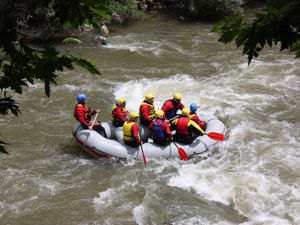In rafting you choose a river and follow the course on a raft specially designed to maneuver the obstacles you might face. The rafts are usually inflatable boats, consisting of very durable, multi-layered rubberized or vinyl fabrics with several independent air chambers. The varying gradient, constriction, obstruction and flow rate of the river makes river rafting a challenging recreational outdoor activity.
Comparison chart
White water rafting is done on white water, which means different degrees of rough water, in order to thrill and excite the raft passengers. This leisure sport became popular in the mid-1970s.
Four factors cause white water
- When a river's gradient increases enough to disturb its laminar flow and create turbulence, i.e. form a bubbly, or aerated and unstable current; the frothy water appears white.
- When a river's flow is forced into a narrower channel.
- When a boulder or ledge obstruct the flow of the river
- When there is a marked increase or decrease. Increase in flow may be due to melting of snow or excessive rain. Decrease may be due to lack of rain.
Scale
Based on the Scale of River Difficulty, river water is graded from Grade 1 to Grade 6 with increasing order of difficulty. Grade 3 and above is classified as white waters. Similarly the rivers are also classified for white waters from Class I to Class VI again in increasing order of difficulty.



 Rapid
Rapid  Paragliding
Paragliding  Skiing
Skiing  Airsoft
Airsoft  Scuba Diving
Scuba Diving  Rappelling
Rappelling
Comments: River Rafting vs White Water Rafting